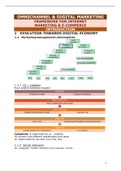OMNICHANNEL & DIGITAL MARKETING
FRAMEWORK FOR INTERNET
MARKETING & E-COMMERCE
INTRODUCTION
1 EVOLUTION TOWARDS DIGITAL ECONOMY
1.1 Marketingmanagement philosophies
1.1.1 Co – creation
From local to extensive creation
Developer
Traditional market Research (feedback)
Mass customizer
Minor modification (color style)
Idea collection
ideation contests (color, style) example: Lays
Integrator
long - term involvement throughout innovation process
facilitator
provide platform for stakeholders co - creation
Complexity à continuum for co – creation
!!! connect with different stakeholders and ideas
Vb: digital platforms like Ikea, Coca Cola, Dell, …
1.1.2 Social networks
Vb: Instagram, Twitter, Facebook (very popular), TikTok, …
1
,1.1.3 On – demand economy
Vb: Uber, Air Bnb, Lyft
Uber – disruptive business model
• Drivers as independent contractors, no costs in terms:
o wages
o driver training
o health insurance
• Regulatory control over passengers´safety
• Dynamic pricing
• Violation of privacy
1.1.4 Digital transformation & sustainable development
Sped up in the last year due to COVID pandemic
Paths of digital change
a) Innovation = creating value by doing the same thing better
b) Digitalization = converting analog information to digital format
c) Digitalization = use of digital technologies (change business model and
create revenue)
d) Digital transformation = journey of strategically planned organizational
change to dominate of stay relevant in a competitive marketplace by
leveraging disruptive technologies
Sustainable development
= combining people, profit and planet
• Challenges: energy crisis
• Companies set sustainable development goals
1.2 One – to – one marketing & many – to – many marketing
Use interactive technologies
and databases (1 customer
at time à relationship)
!!! necessity to link front
and back office
2
,O = organization
C = customer
M = message
C = content
One – to – one
One – to – many Many – to – many
internet
tradional communication
Based
Mass communication Via internet
communication
1.3 Emerging digital economy: implications
• balance between speed & knowledge
• globalization - global competition
• virtual marketplaces & shorter product/service life cycles
• networking and partnerships (intranet, extranet & internet)
à building relationships
• mass customization opportunity
• focus on business processes (efficiency !!)
• new business models/roles in e-commerce
• relationship with customer changes due to technology (face – to – face à
screen – to – face interaction)
• value creation: physical goods à favor services, information &
intelligence
1.4 New economies of information: richness & reach
Vb: advertising (low riskness, high reach)
• Accessibility
• Entry barriers
• Disintermediation = brand companies can directly communicate
customers without intermediate stores, …
• Buyer search costs (due to internet lot lower)
• Mass customization
• Relationship marketing
1.5 Growth / penetration of internet stats
See dia 58
3
, 2 E – COMMERCE: EVOLUTION & DEFINITION
2.1 Defining e – commerce & e – business
E – BUSINESS
= Digital enabling of transactions and processes within a firm, involving
information systems under firm’s control
!!! Does not include commercial transactions involving an exchange of value
across organizational boundaries
E – COMMERCE
= use of internet and web to transact business
= Digitally enabled commercial transactions between and among organizations
and individuals
Technological building blocks (underlying e – commerce)
• Internet = worldwide infrastructure
• World wide web = part of internet
o HTML
o Deep web (subscription content, databases, encrypted content) vs
“surface” web (visible)
• Mobile platforms: apps
Trends in e – commerce
a) Business trends: Covid-19 pandemic fuels surge in retail e-commerce, m-
commerce, and certain on-demand services
b) Technology trends:
a. Mobile platform and cloud computing
b. Big data and Internet of Things (connection with others)
c) Societal trends
a. Increased concern about impact of social networks
b. Concerns about increasing market dominance of big technology
firms (monopoly)
2.2 History
1995 – 2000: invention
• Key concepts developed
• Limited bandwidth and media
• Euphoric visions of
o Friction-free commerce: lowered search costs, disintermediation,
price transparency, elimination of unfair competitive advantage
o First-mover advantages: network profits
• Dot – com crash of 2000
2001 – 2006: consolidation
• Emphasis on business-driven approach
• Traditional large firms expand presence
• Start-up financing shrinks
• More complex products and services sold
• Growth of search engine advertising
• Business Web presences expand
4





